DIY copper pipe installation: copper pipe installation technology
A domestic water network assembled from elements of a copper pipe rolling is considered one of the most reliable. Of course, the arrangement of such a highway is not cheap. However, the high cost of the water supply pays off for its durability and other significant advantages.
In order to somehow save the budget of water supply, you can do the installation of copper pipes with your own hands, having previously studied the technology of work. Doubt your own abilities?
We will tell you what tools you need to prepare, describe the step-by-step processes for assembling a copper pipeline by soldering, as well as using crimp fittings. The above photo instructions and practical tips will help to avoid errors and equip a reliable engineering network.
The content of the article:
Copper as a material for the manufacture of pipes
Copper is the optimal material that ensures the operability of systems at high pressures and temperatures. Therefore, a copper pipe is used not only for the installation of domestic hot water pipes or heating mains, but also for other purposes.
For comparison, you can take polypropylene pipes and copper. The former are able to withstand temperatures only up to + 95ºС at pressures not exceeding 25 ATI. The second ones are able to work at Т = 250ºС and pressures up to 300 MPa.
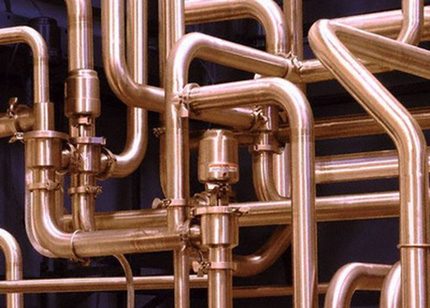
Copper is the main material from which the French, British, Australians, and Swedes prefer to mount water supply and heating systems. High mechanical strength, ease of machining - these properties have made seamless copper pipes popular in the construction of various kinds of communications.
The modern production of such products involves the application of a protective polymer layer on the surface of pipes, eliminating the appearance of stray currents in zones of magnetic fields.
The nuances of installing copper lines
Plumbers with a set of tools and experience working with copper perform a number of actions during the installation of copper pipelines:
- stripping, calibration, cutting;
- shaping;
- compression, soldering, connection.
Each owner of an apartment or a private house can do the same actions with his own hands.
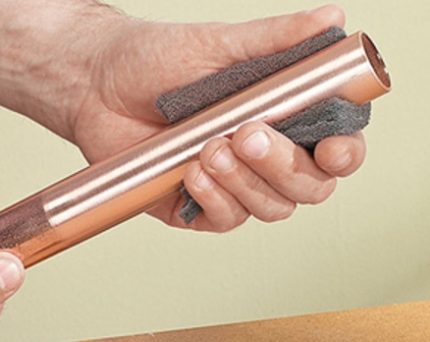
The main thing is to learn the nuances of technology and the secrets of the production of such works. Each action requires an appropriate tool.
Typically, a tool kit includes:
- copper pipe cutter or hacksaw;
- files, sandpaper, rags;
- metalwork wrenches;
- gas key No. 1;
- manual calibrator, pipe bender;
- gas stove, flux, solder, tape fum.
The beginning of installation work is always preceded by activities aimed at the calculation and drawing up water distribution schemes or heating system.

Based on their schemes, the required number of copper pipes, their length size, diameter, as well as the number of additional mounting parts are calculated.
Methods of connecting copper pipes
In practice, one of two methods of assembling copper pipelines is used - by soldering or mechanical crimping.
The secrets of gas soldering
When choosing a soldering method for mounting the system, it is necessary to consider the following: all connections made in this way are one-piece.Soldering provides a high percentage guarantee of density, but imposes some limitations on maintenance. It is often not possible to upgrade a system without additional complexity.
So, if it is necessary to change some part of the water supply system (heating system), for example, due to the introduction of new equipment, difficulties may arise. You will have to reuse the gas burner and soldering technique only in order to be able to incorporate a coupling, tee or other part into the system.
Therefore, soldered joints are used in projects of concealed water pipes walled up in walls or under floors.

The soldering process is inextricably linked with the operation of a gas burner (open flame and combustion products). Therefore, such a technique is not always suitable for installation, especially in rooms where a fine finish was previously performed.
Step-by-step soldering process:
- Two pipes are cut to size. The end area is cleared of burrs.
- The end part of one of the pipes is expanded by a calibrator - a bell is made.
- With a metal brush and emery paper, they clean the soldering spots to a shine.
- The cleaned surfaces are treated with a flux solution.
- Machined parts are inserted one into another.
- The junction is heated with a burner to the melting point of the solder (350-500ºС).
- The end of the solder bar touches the lower edge of the socket.
Under the influence of high temperature, the solder melts and rushes into the gap between the walls of the pipe and socket due to the capillary effect created by the flux vapor. This results in a neat and high quality solder joint. This is just one example of pipe-in-pipe brazing.
In the same way, soldering with fittings and other elements is carried out.
Step-by-step instructions for soldering copper pipes, as well as technical nuances of the work are given in this article.
Crimp fittings
It is much simpler and easier to do the installation of copper pipes with your own hands, if you use another widely used technology - mechanical crimping. In this case, special fittings are used to create a connection of copper pipes.
Approximately the same elements are used in working with polypropylene pipes. But for copper, a slightly different design of the crimp ring is made - solid, without a cut.
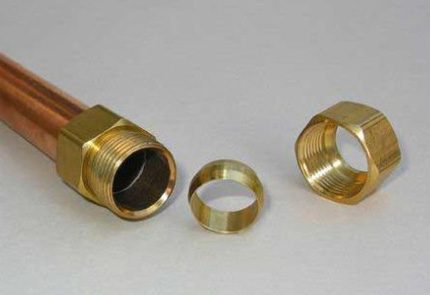
Crimp fittings are made of brass. Judging by the degree of plasticity of the materials, these values for copper and brass are almost the same. An important feature of brass-copper pairing is the almost complete absence of galvanic bonding between materials.
This factor guarantees the purity of the compound during operation - the absence of oxides, corrosion, etc.
The situation is completely different with aluminum. This metal, unlike brass, galvanically binds to copper. Under conditions when tap water is saturated with salts, that is, it is an active electrolyte, a favorable environment for the occurrence of an electrochemical reaction is formed.
Under the influence of such a reaction, aluminum is destroyed. Therefore, the direct connection of copper pipes and aluminum radiators (or other aluminum appliances) is undesirable. Steel transitions should be used, for example.
Crimp fitting installation:
- The end region of the pipe is deburred.
- A nut, crimp ring, fitting is put on the end of the pipe.
- With a wrench to the desired size, the fitting is held in one position.
- With a second wrench, the nut is screwed onto the thread of the fitting.
The connection density is achieved by uniformly clamping the crimp ring along the diameter of the copper pipe. Extreme force is not recommended when tightening the nut. From the place of initial stop it is enough to stretch the nut 1-2 turns.
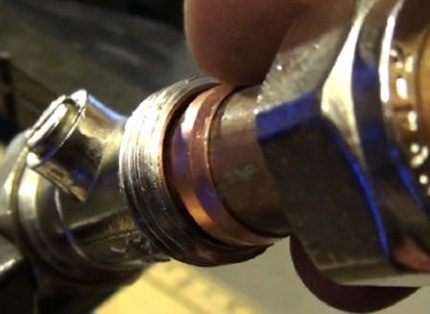
Benefits press connector applications - they can be disassembled and reassembled if necessary. But at the same time, the quality of compaction of such compounds is affected by changes in the temperature of the external and internal environment.
Often, due to temperature changes, crimp connections leak. Such a defect is eliminated simply and quickly - by tightening the union nut.
However, for the hidden installation of a water supply system, the technique of crimping collet joints of copper pipes is clearly not suitable.
Tools for mounting elements
It is not always possible to cut a pipe without breaking the wall structure. The wall thickness of copper pipes up to a diameter of 28 mm is only 1 mm. Even the use of disk pipe cutter for copper pipes does not give full guarantees of evenness of cut. If wall disturbances are observed, use a calibrator. With this tool, the pipe and socket are calibrated (aligned).
Pipe cutters are produced manual, electric, pneumatic, hydraulic. Structurally, the pipe cutter is a mechanical clamp, where two rollers act as supporting elements. One of the rollers has a cutting edge.
The cutting process is carried out by sequentially pressing and scrolling the pipe cutter around the axis of the pipe. The smoother and more often the pressing is performed, the better the pipe section is obtained.
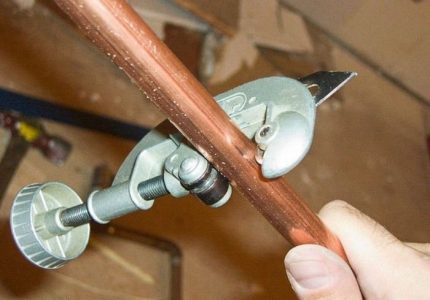
Installation work is often accompanied by bending of copper pipes. High-quality smooth bending with any radius helps to create a tool called a pipe bender. There are two types of copper pipe benders - spring and mechanical.
The first tool has a simple but effective design. Intended for bending pipes of small diameter. The second type includes several structural varieties.
The spring bender is made in the form of a long casing, which is worn on a copper pipe. One end of such a casing is slightly expanded for greater ease of use. A copper pipe placed in such a springy sheath is bent manually without the risk of jamming at the bend.
Disadvantages - the bending radius has to be verified by eye, for a specific pipe diameter you need your own spring bender.
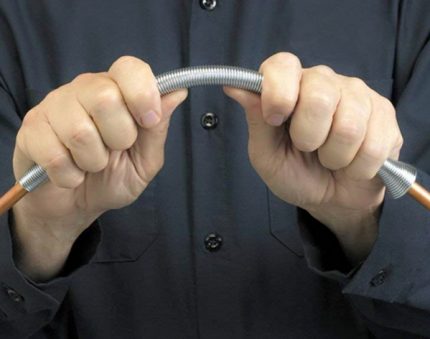
Mechanical pipe benders (lever, segment, crossbow, hydraulic) allow bending pipes of different diameters (from 10 to 125 mm). Large diameter copper pipes are usually bent segmented and hydraulic pipe bender. The bending angle when working with such devices can be 180 °.
Copper plumbing specifications
Durability copper water pipes to some extent, due to the fact that chlorine contained in water in reaction with copper promotes the formation of a thin oxide film on the inner surface. This film additionally protects the pipe wall from the negative influence of the pumped medium.
Also, copper is considered the optimal material according to the results of sanitary-bacteriological studies. This metal has a bacteriological effect, for example, against staphylococcus virus.
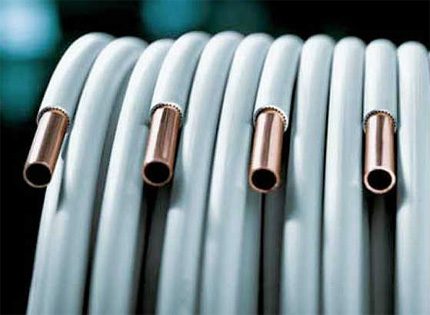
Copper has a high coefficient of thermal conductivity.This moment forces to take measures aimed at isolating the pipes from the external environment.
Non-insulated water supply to the cold water supply during the summer period can create a serious problem for the collection and removal of condensate. Significant heat losses are noted on uninsulated hot water pipes. Carrying out the installation of networks of copper pipes with your own hands, these points should be taken into account.
Conclusions and useful video on the topic
You can learn about how to install a copper water supply system from the following video:
Quality, reliability, durability - water and heating systems endowed with these properties often delight owners of apartments and houses if copper is used for installation work.
Indeed, when there is confidence that there are no leaks and is not foreseen in the future, that gusts are not destined to be even harsh in winter, this means a system of copper pipes is mounted in the house.
Is there anything to supplement, or have questions about the technology for installing copper pipes? Please leave comments and participate in discussions about the publication. The contact form is located in the lower block.

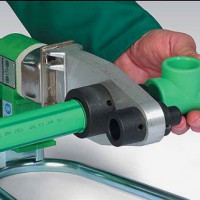 DIY installation of polypropylene pipes: technology for working with PP piping
DIY installation of polypropylene pipes: technology for working with PP piping 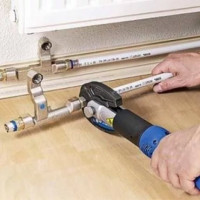 Do-it-yourself installation of plastic pipes: connection technology and wiring examples
Do-it-yourself installation of plastic pipes: connection technology and wiring examples 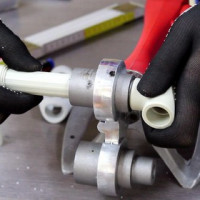 DIY welding technology for polypropylene pipes: an overview of methods and nuances
DIY welding technology for polypropylene pipes: an overview of methods and nuances  DIY installation of HDPE pipes: welding instructions + how to bend or straighten such pipes
DIY installation of HDPE pipes: welding instructions + how to bend or straighten such pipes 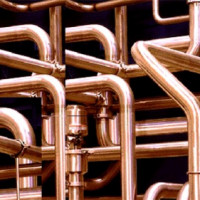 Connecting copper pipes: instructions and comparison of various installation technologies
Connecting copper pipes: instructions and comparison of various installation technologies 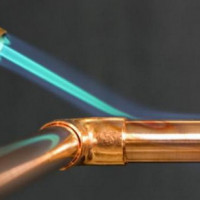 Soldering of copper pipes: step-by-step analysis of work and practical examples
Soldering of copper pipes: step-by-step analysis of work and practical examples  How much does it cost to connect gas to a private house: the price of organizing gas supply
How much does it cost to connect gas to a private house: the price of organizing gas supply  The best washing machines with dryer: model rating and customer tips
The best washing machines with dryer: model rating and customer tips  What is the color temperature of light and the nuances of choosing the temperature of the lamps to suit your needs
What is the color temperature of light and the nuances of choosing the temperature of the lamps to suit your needs  Replacement of a geyser in an apartment: replacement paperwork + basic norms and requirements
Replacement of a geyser in an apartment: replacement paperwork + basic norms and requirements